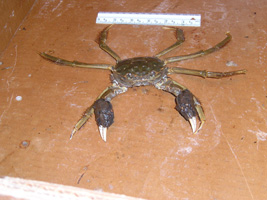Chinese Mitten Crab Alert
for the Hudson River Estuary

Photo by Tom Lake, Estuary Naturalist
Chinese mitten crabs (Eriocheir sinensis) (CMC) is our newest Hudson River invader! The Chinese mitten crab, a non-native species from East Asia, is a costly and environmentally damaging invader in Europe and San Francisco Bay. The first one was caught in early June, 2007 in the Hudson River Tappan Zee section 27 miles upstream from the mouth. As of June 9, 2008, at least three juvenile CMC have been caught - one in Cold Spring, Putnam County and two in Tivoli Bays, Dutchess County, suggesting reproduction is occurring and CMC are rapidly moving upriver. They are among the first caught in the eastern United States coastal waters. A few others have been caught in the Chesapeake Bay and Delaware Bay. About a dozen Chinese mitten crabs have been reported in the Great Lakes - St. Lawrence system since 1965; although a population has not established in this system, more frequent sightings from 2004 - 06 have raised concerns.
These crabs may be found in both freshwater and salt water. They are walking crabs that can emerge from the water to move upstream of barriers and are capable of moving several hundred miles upstream from saltwater. They spend most of their lives in freshwater rivers, migrating to brackish or salt water to reproduce. The young move upstream, sometimes spending 2 - 5 years in freshwater.
Why be concerned? These crabs are aggressive and may compete with our popular native blue crab in the Hudson River. Their burrowing habits may threaten stream bank and earthen dam stability and promote erosion and habitat loss.
How did they get here? We are not certain; however, ship ballast water and live release are the two most likely means.
Identification
- Only freshwater crab in the Hudson River drainage
- Claws equal size with white tips and hair
- Carapace (shell) up to 4 inches wide; light brown to olive color
- Eight sharp pointed walking legs; no swimming legs
If you catch a Chinese mitten crab
- Do not release it back to the water
- Keep it and freeze it (preserve in alcohol if you can't freeze it)
- Note date and location caught (GPS coordinates preferred but pinpointed on a map is acceptable) and how you caught it
- If possible, take a close-up photo. You may e-mail photo to SERCMittenCrab@si.edu for identification.
The Mitten Crab Network, a partnership among several state, federal and research organizations, is collecting data to determine the status, abundance and distribution of this species. New York State Department of Environmental Conservation's Division of Fish, Wildlife and Marine Resources has agreed to collect and hold specimens for genetics testing to determine the origin of individuals caught in the Hudson River.
The Department of Environmental Conservation is seeking the public's assistance in collecting any CMC specimens that may exist in NY. Persons who collect and possess a CMC solely for the purpose of turning the crab over to the Department will not be prosecuted under 6 NYCRR 44.10* for possession or transport violations. Persons collecting and holding CMC for the sole purpose of turning the crab over to the Department must, within 48 hours of collecting the CMC, contact one following individuals:
Long Island Sound, New York Harbor and Hudson River below George Washington Bridge: Kim McKown, NYS DEC Division of Fish Wildlife and Marine Resources Crustacean Unit, 631-444-0454
Hudson River above George Washington Bridge: Mark Dufour, NYS Division of Fish, Wildlife and Marine Resources Hudson River Fisheries Unit, 845-256-3171 or 845-256-3071; Hudson River Estuary Research Reserve, 845-889-4745 or e-mail r3hrf@gw.dec.state.ny.us
NOTE:
* NYS Fish and Wildlife regulations (Section 44.10) prohibit releasing Chinese mitten crab into waters of New York State; prohibits possession, importation, transportation, purchase or sale or offer of purchase or sale of Chinese mitten crab whether dead or live. This regulation requires Chinese mitten crab to be destroyed unless lawfully held under a license or permit to collect, possess or sell for propagation, scientific or exhibition purposes issued under section 11-0515 of the Environmental Conservation Law. In addition, the Federal Lacey Act prohibits inter-state transport of Chinese mitten crabs.





